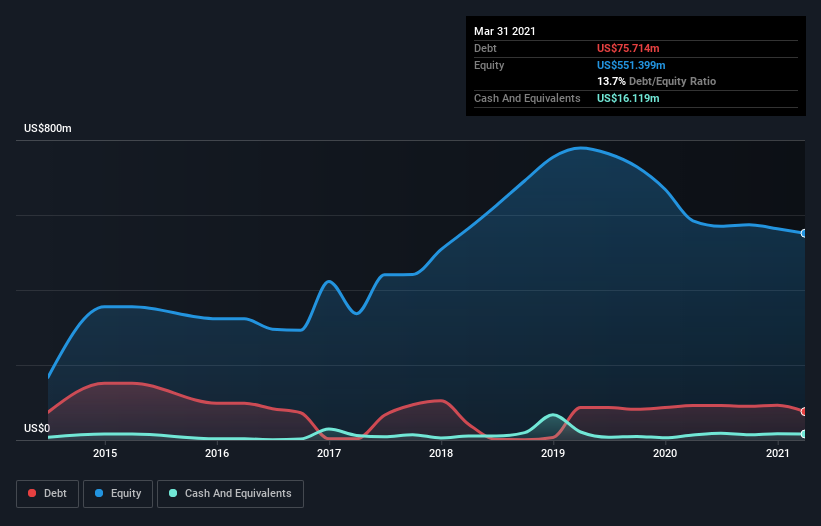- United States
- /
- Energy Services
- /
- NasdaqGS:TUSK
Is Mammoth Energy Services (NASDAQ:TUSK) Using Too Much Debt?
Warren Buffett famously said, 'Volatility is far from synonymous with risk.' So it seems the smart money knows that debt - which is usually involved in bankruptcies - is a very important factor, when you assess how risky a company is. As with many other companies Mammoth Energy Services, Inc. (NASDAQ:TUSK) makes use of debt. But the more important question is: how much risk is that debt creating?
When Is Debt A Problem?
Debt and other liabilities become risky for a business when it cannot easily fulfill those obligations, either with free cash flow or by raising capital at an attractive price. In the worst case scenario, a company can go bankrupt if it cannot pay its creditors. While that is not too common, we often do see indebted companies permanently diluting shareholders because lenders force them to raise capital at a distressed price. Of course, the upside of debt is that it often represents cheap capital, especially when it replaces dilution in a company with the ability to reinvest at high rates of return. The first step when considering a company's debt levels is to consider its cash and debt together.
Check out our latest analysis for Mammoth Energy Services
How Much Debt Does Mammoth Energy Services Carry?
The image below, which you can click on for greater detail, shows that Mammoth Energy Services had debt of US$75.7m at the end of March 2021, a reduction from US$92.1m over a year. However, it does have US$16.1m in cash offsetting this, leading to net debt of about US$59.6m.

How Healthy Is Mammoth Energy Services' Balance Sheet?
We can see from the most recent balance sheet that Mammoth Energy Services had liabilities of US$119.6m falling due within a year, and liabilities of US$109.4m due beyond that. Offsetting this, it had US$16.1m in cash and US$402.5m in receivables that were due within 12 months. So it actually has US$189.6m more liquid assets than total liabilities.
This excess liquidity is a great indication that Mammoth Energy Services' balance sheet is almost as strong as Fort Knox. On this view, lenders should feel as safe as the beloved of a black-belt karate master. There's no doubt that we learn most about debt from the balance sheet. But you can't view debt in total isolation; since Mammoth Energy Services will need earnings to service that debt. So if you're keen to discover more about its earnings, it might be worth checking out this graph of its long term earnings trend.
Over 12 months, Mammoth Energy Services made a loss at the EBIT level, and saw its revenue drop to US$282m, which is a fall of 39%. That makes us nervous, to say the least.
Caveat Emptor
Not only did Mammoth Energy Services's revenue slip over the last twelve months, but it also produced negative earnings before interest and tax (EBIT). Indeed, it lost a very considerable US$84m at the EBIT level. That said, we're impressed with the strong balance sheet liquidity. That should give the business time to grow its cashflow. The company is risky because it will grow into the future to get to profitability and free cash flow. When analysing debt levels, the balance sheet is the obvious place to start. But ultimately, every company can contain risks that exist outside of the balance sheet. These risks can be hard to spot. Every company has them, and we've spotted 3 warning signs for Mammoth Energy Services (of which 1 makes us a bit uncomfortable!) you should know about.
If you're interested in investing in businesses that can grow profits without the burden of debt, then check out this free list of growing businesses that have net cash on the balance sheet.
If you decide to trade Mammoth Energy Services, use the lowest-cost* platform that is rated #1 Overall by Barron’s, Interactive Brokers. Trade stocks, options, futures, forex, bonds and funds on 135 markets, all from a single integrated account. Promoted
New: Manage All Your Stock Portfolios in One Place
We've created the ultimate portfolio companion for stock investors, and it's free.
• Connect an unlimited number of Portfolios and see your total in one currency
• Be alerted to new Warning Signs or Risks via email or mobile
• Track the Fair Value of your stocks
This article by Simply Wall St is general in nature. It does not constitute a recommendation to buy or sell any stock, and does not take account of your objectives, or your financial situation. We aim to bring you long-term focused analysis driven by fundamental data. Note that our analysis may not factor in the latest price-sensitive company announcements or qualitative material. Simply Wall St has no position in any stocks mentioned.
*Interactive Brokers Rated Lowest Cost Broker by StockBrokers.com Annual Online Review 2020
Have feedback on this article? Concerned about the content? Get in touch with us directly. Alternatively, email editorial-team (at) simplywallst.com.
About NasdaqGS:TUSK
Mammoth Energy Services
Operates as an energy services company in the United States, Canada, and internationally.
Flawless balance sheet and good value.
Similar Companies
Market Insights
Community Narratives


Recently Updated Narratives

Constellation Energy Dividends and Growth

CoreWeave's Revenue Expected to Rocket 77.88% in 5-Year Forecast

Bisalloy Steel Group will shine with a projected profit margin increase of 12.8%
Popular Narratives


MicroVision will explode future revenue by 380.37% with a vision towards success


NVDA: Expanding AI Demand Will Drive Major Data Center Investments Through 2026



